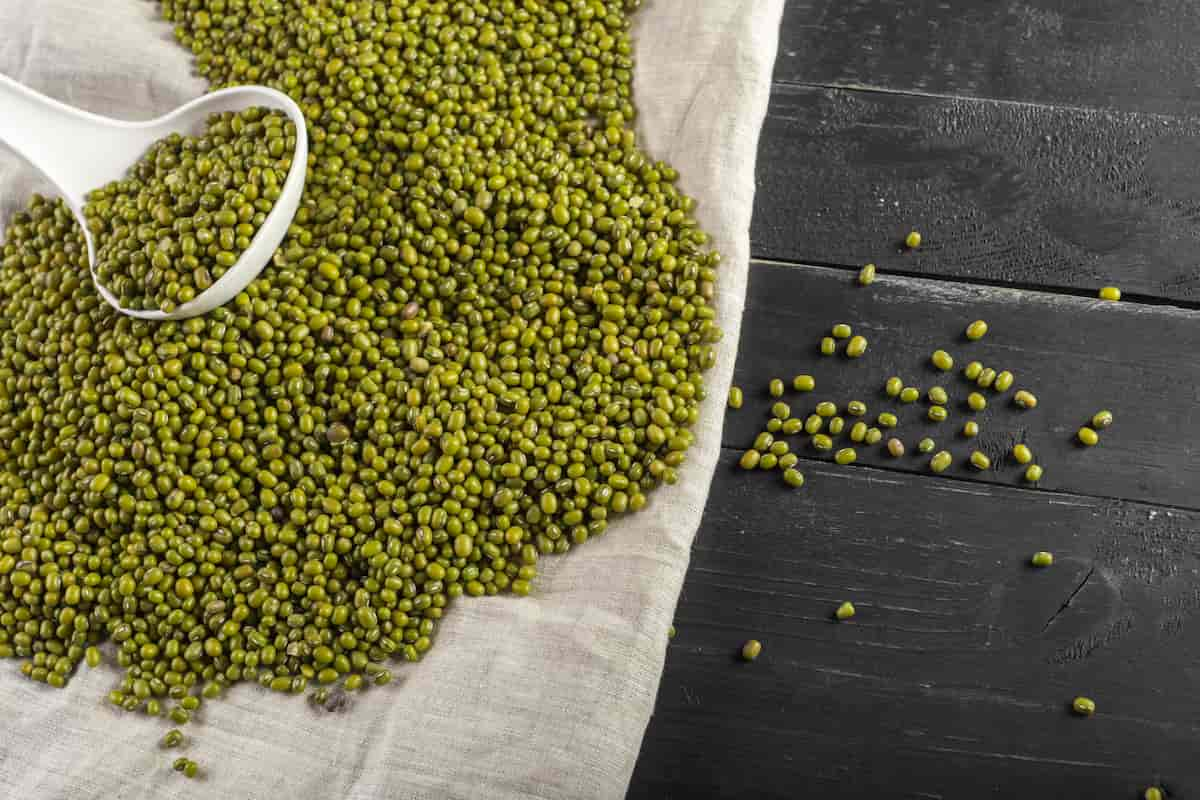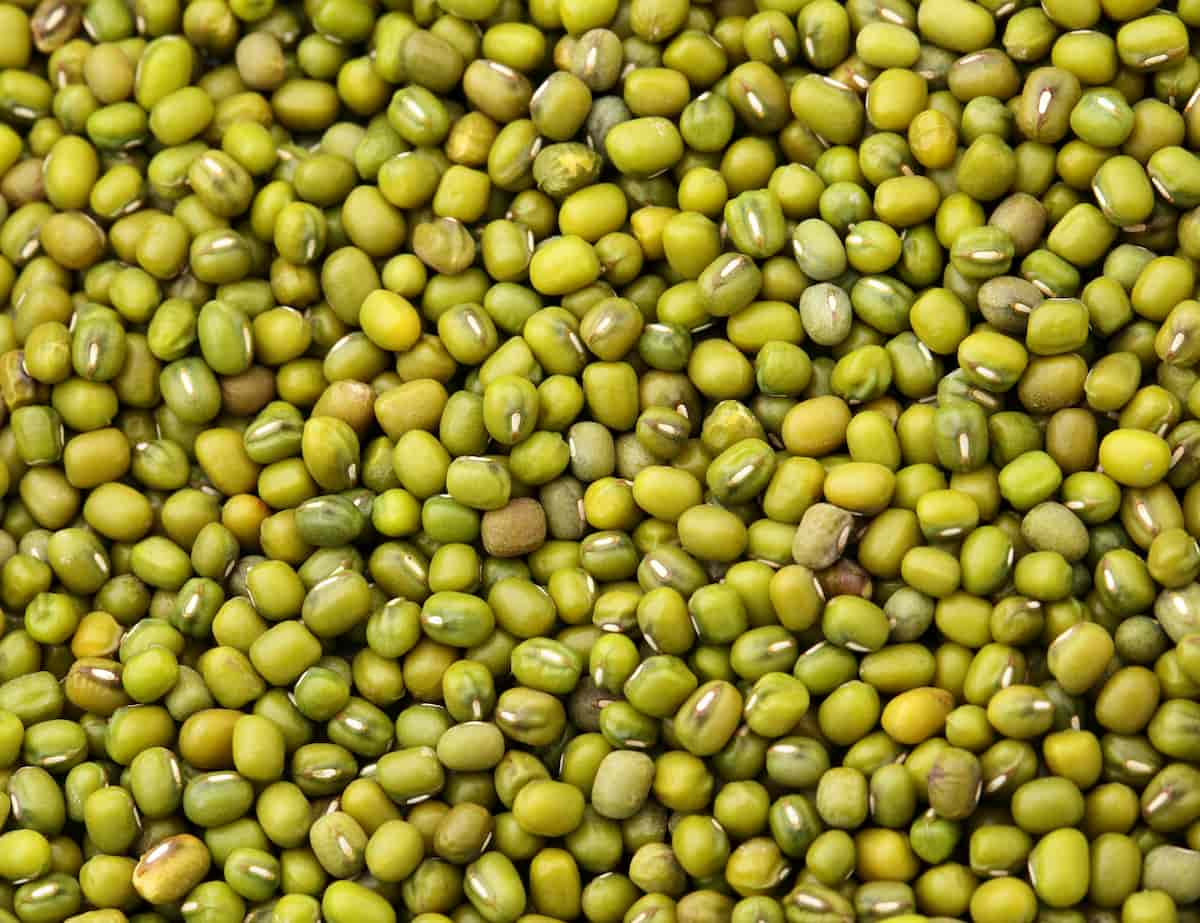Green gram, or mung bean, is a popular pulse product in India due to its high nutritional value. Since it contains protein and other vital nutrients, it is useful for human and livestock food. Green gram has been increasingly cultivated in recent years in response to rising demand for the food on the strength of research pointing to its health advantages.

The Kharif season, which begins in June and lasts until October, is optimal for growing green grams. The pods thrive in hot and humid climates and can be planted in various soil types (from sandy loam to clay loam to black soil). The first step in farming is plowing the area and preparing it for planting.
When planting seedlings in rows, a depth of 3 to 5 centimeters and a row spacing of 30 to 45 centimeters is recommended. The seedlings emerge, and after 10-15, the field is weeded and thinned so that there are 10 centimeters between each plant. The crop can be harvested 60 to 80 days after sowing, depending on the variety, management practices, and growing conditions.
1 Acre Green Gram Cultivation Project Report in India
Market and Demand for Green Gram Cultivation
Green gram is a nutrient-rich pulse crop that is in high demand in India and around the globe. By 2026, the world market for green gram is predicted to have expanded at a CAGR of 5.7% from the previous forecast period of 2021-2026. Demand for healthy food products is being pushed by consumers’ increasing knowledge of the importance of eating nutritiously.
In 2020-21, India will produce 3.5 million metric tons of green gram, making it the world’s biggest crop producer. China isn’t the only country that grows a lot of green gram; Myanmar, Thailand, and China are also significant players. Across India, the regions of Uttar Pradesh, Madhya Pradesh, Rajasthan, and Maharashtra are the most important for the production of green gram.
Government procurement organizations buy green gram from farmers at minimum support prices (MSP). Soups, stews, and salads are just a few examples of how green gram can be used in the kitchen. It’s also on the ingredients list for packaged foods like chips, noodles, and soups.
Best Green Gram High Yield Variety for Green Gram Cultivation
These varieties are Mohini, SML 668, Sheela, Pusa Vishal, RMG 268, Pant Moong 1, PS 16, and AKM 98101. These varieties are early maturing and suitable for all seasons.
- SML 668 is an early maturing variety with hard grains that can yield 15 to 20 quintals per hectare.
- Mohini can tolerate the yellow mosaic virus and yield 10-12 quintals per hectare.
- Sheela can give a 15-20 quintal yield per hectare and is suitable for the climate of North India.
- Pusa Vishal matures in 70-75 days, yielding 15-20 quintals per hectare.
- RMG 268 is drought-resistant and can provide up to 28% higher yield.
- Pant Moong 1 is ready to mature in 75 days, yielding 10-12 quintals per hectare.
- PS 16 can yield up to 10-15 quintals per hectare and is suitable for rainy and summer seasons.
- AKM 98101 is another early maturing variety that can yield up to 12-15 quintals per hectare.
In case you missed it: 1 Acre Sorghum Cultivation Project Report in India: Production Cost and Profit

Cost of Cultivation for 1-Acre Green Gram Cultivation in India
- Human labor: For 1-acre Green Gram cultivation in India, this cost includes paying laborers for sowing, weeding, and harvesting. Depending on area rates and labor availability, it costs Rs. 3500-4000
- Land preparation cost covers plowing, leveling, and other sowing preparation costs. Depending on the soil and tools, it costs Rs. 2500–3000.
- Seed: High-quality Green Gram seeds cost money. Depending on seed quality and amount, it costs Rs. 1000-1200 per acre.
- Fertilizer & manure: This fee covers buying and applying fertilizers and manure to the soil for Green Gram growth. Depending on dirt and fertilizer, an acre costs Rs. 2500–3000.
- Insecticides/plant protection: The cost of buying and applying insecticides or other plant protection methods to shield the crop from pests and diseases. Depending on pest infestation and security methods, the cost per acre is Rs. 1200-1500.
- Harvesting and other: This involves crop harvesting, transportation, and storage. Depending on the gathering method and market distance, an acre costs Rs. 2500-3500.
The total cost of cultivation for 1-acre green gram cultivation in India ranges from Rs. 13,200 to Rs. 16,700.
Total Returns from 1 Acre Green Gram Cultivation
The medium-sized, bright green grains of a green gram is widely consumed in India and other parts of the world. On average, one acre of green gram cultivation can yield 5-7 quintals of grains. The current market prices for green gram range from 5500.00 to 7500-8000.00 INR per quintal for whole grains. The cost of varieties is approximately 7200.00 INR per quintal.
Total revenue = Average yield per acre x Average price per quintal i.e., 6 x 7200 = INR 43,200. It is important that income may differ based on crop quality, variety, market demand, price, etc.
Net Profit from 1-Acre Green Gram Cultivation
- The total cost of cultivation for 1-acre green gram cultivation in India ranges from Rs. 13,200 to Rs. 16,700.
- The total revenue from one acre of green gram cultivation would be 43200 INR.
- Net profit is subtracting the total cost of cultivation (which ranges from 13,200 to 16,700 INR, as we calculated earlier) from the total revenue.
- Net profit = Total revenue – Total cost of cultivation i.e., 43200 – 13200 to 16700 = INR 26500 to 30000.
When production costs and other costs are considered, the net profit from growing Green Gram on an acre of land can range from 26,500 INR to 30,000 INR, depending on the market price and how the crop is grown. Profits include production costs and other fees like seeds, fertilizers, labor, and irrigation. Seed quality and farming methods can affect yield and income.
In case you missed it: 1 Acre Red Gram Cultivation Project Report in India: Production Cost and Profit

Conclusion
1-acre Green Gram cultivation in India can be a profitable venture with a potential revenue of up to 35,000 INR. However, production costs, quality of seeds, farming practices, and market trends should be considered to maximize profits.
- Feed Your Flock for Less: Top 10 Tips to Save on Chicken Feed
- Ultimate Guide to Ossabaw Island Hog: Breeding, Raising, Diet, and Care
- Hatching Answers: The Top 10 Reasons Your Chickens Aren’t Laying Eggs
- Eggs and Economics: Breaking Down the Cost of Raising Backyard Chickens
- Defend Your Greens: Proven Methods to Keep Iguanas Out of Your Garden
- Ultimate Guide to Cinnamon Queen Chicken: A Comprehensive Guide for Beginners
- Ultimate Guide to California Tan Chicken: Breeding, Raising, Diet, Egg-Production and Care
- Ultimate Guide to Marsh Daisy Chicken: Breeding, Raising, Diet, and Care
- 10 Types of Chicken Farming Businesses You Can Start for Profits